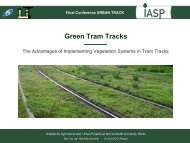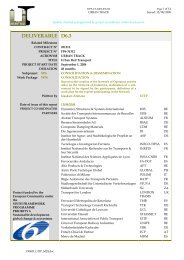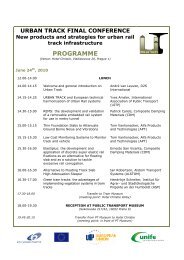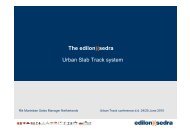DELIVERABLE 2.8 - urban track
DELIVERABLE 2.8 - urban track
DELIVERABLE 2.8 - urban track
You also want an ePaper? Increase the reach of your titles
YUMPU automatically turns print PDFs into web optimized ePapers that Google loves.
Figure 3.4<br />
D0208_STIB_M24.doc<br />
TIP5-CT-2006-031312 Page 28 of 44<br />
URBAN TRACK Issued: August 13, 2008<br />
Quality checked and approved by project co-ordinator André Van Leuven<br />
LCC (Life Cycle Cost) analyses have very clearly shown the positive effect on life cycle costs and<br />
maintenance work. This optimum course taken by the forces involved will result in a reduction of both<br />
rail and wheel wear.<br />
The <strong>track</strong> serves as guidance for the moving vehicle and is responsible for its dynamics. For the<br />
investigation of kinematics, at least a general point in the cross section of the vehicle has to be observed,<br />
not a point in the <strong>track</strong> plane, which is from a mathematics view a singular plane. For the dynamics,<br />
Newton’s and Euler’s laws have to be taken into consideration. For both, the centre of gravity is the<br />
decisive point. Therefore, <strong>track</strong> alignment design has to be performed for this centre. The <strong>track</strong> should<br />
provide continuous variations for at least velocities and accelerations and preferably also jerks<br />
everywhere within the vehicle.<br />
On the other hand, the <strong>track</strong> is the support structure for internal forces (in the rails) and external forces<br />
caused by the moving vehicles. The continuous welded rails have to be bent and kept in the required<br />
shape. This is only possible with a special continuous variation of cant gradient. In a ramp, the railroad<br />
<strong>track</strong> is always stressed.<br />
The normalized pattern and derivatives look like:<br />
Normalized constant cant gradient and curvature and derivatives<br />
The kinematics induced by a constant cant gradient without rounded connections are typical. There is a<br />
step in the elevation angles of the cant gradient at the boundaries. The sway (roll) angular velocity is<br />
discontinuous, therefore the sway (roll) angular acceleration is infinite, which causes also the non-<br />
compensated transverse acceleration in the centre of gravity to be infinite. The sway (roll) angular jerk is<br />
infinite, which causes also the non-compensated transverse jerk in the centre of gravity to be infinite. If<br />
only the outer rail is elevated also vertical acceleration and jerk are infinite. Rounded connections are<br />
needed to remove these singularities, which elongate the cant gradient in an undefined manner. With<br />
circular rounded connections, only accelerations are limited, but not the jerks.<br />
Another important aspect is to consider the rail(s) as (a) bended beam(s). For the bending of the rail, in<br />
that context a simple Bernoulli - Euler – model suffices.








